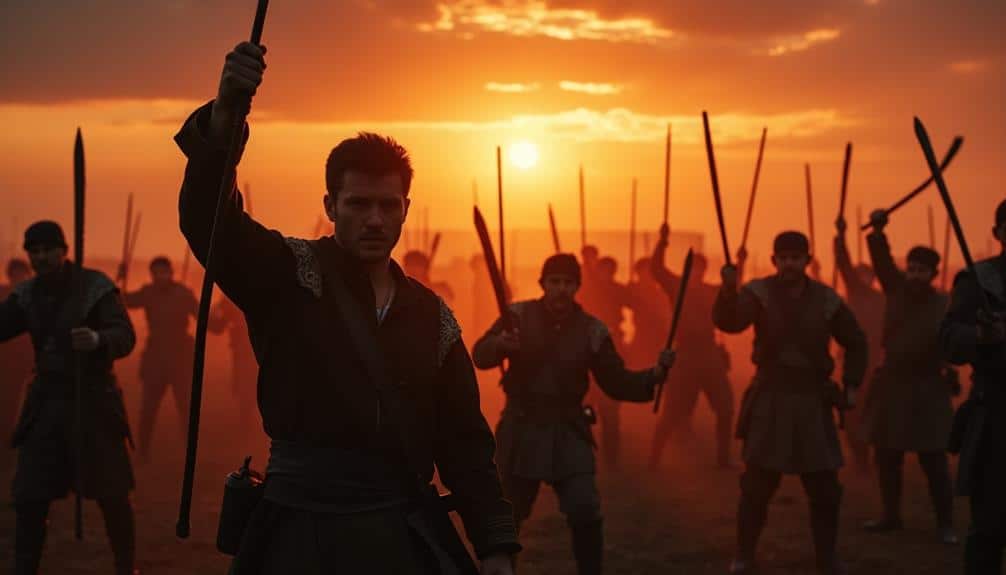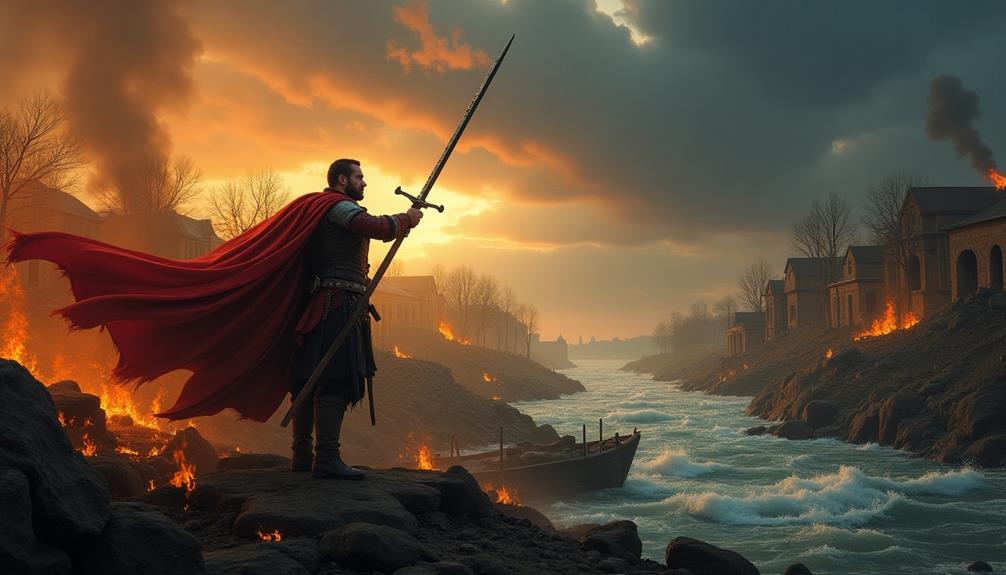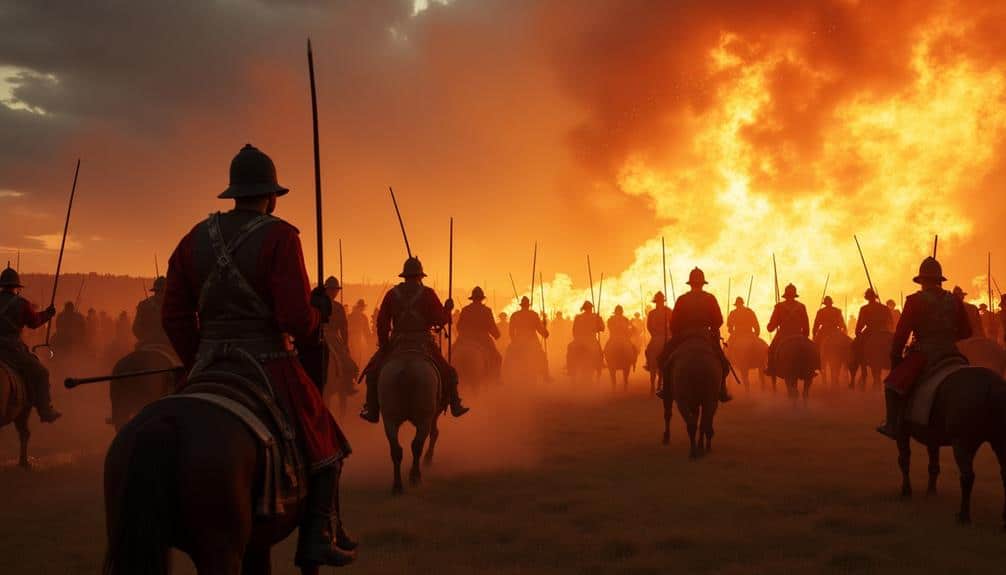In the tumultuous landscape of 17th-century Russia, the Peasant War of 1667-1671, spearheaded by the indomitable Stenka Razin, emerged as a formidable challenge to the entrenched feudal systems. Razin, a Cossack leader whose name would become synonymous with rebellion, orchestrated a movement fueled by the grievances of the oppressed peasantry. His campaign, marked by audacious tactics and a quest for justice, posed questions about authority and the resilience of the human spirit. Yet, as we explore the intricate dynamics of this historical upheaval, the true complexity of Razin’s legacy invites further contemplation.

The Peasant War of 1667-1671 in Russia was a significant uprising driven by widespread discontent among the lower classes and marked by socio-economic and political turmoil.
At the forefront of this rebellion was Stenka Razin, a charismatic Cossack leader whose actions and leadership galvanized thousands.
This conflict not only highlighted the deep-seated grievances against feudal oppression but also underscored the precarious nature of Tsarist authority during the period.
Russia’s Peasant War (1667-1671) and Stenka Razin
Amidst the turbulent socio-political landscape of 17th-century Russia, the Peasant War of 1667-1671 emerged as a significant uprising challenging the feudal order. This rebellion stemmed from deep-seated grievances against the oppressive social hierarchy, burdening lower classes with taxes and labor obligations to landowners.
Cossack Autonomy and Leadership
Discontent was further fueled by the desire for Cossack autonomy, a group known for their fierce independence and military skills. These factors coalesced into a broader rebellion motivated by economic hardship and a yearning for freedom from feudal constraints.
Central to this revolt was Stenka Razin, a charismatic Cossack leader who galvanized the diverse forces of the uprising. Razin’s ability to articulate the shared frustrations of peasants and Cossacks made him a potent symbol of resistance against Tsarist authority.
The Role of Cossack Society
Cossack society played a pivotal role in the socio-political landscape of 17th-century Eastern Europe. Characterized by a distinctive identity, this society was marked by a unique blend of military organization and social structure. The Cossack hierarchy was notably egalitarian, offering members a degree of autonomy rarely found in feudal systems. This autonomy fostered a strong sense of freedom essential to their traditions.
Cossack traditions were rooted in martial culture, with warfare serving as both survival and a defining element of their identity. Their military engagements expressed sovereignty against encroaching powers, enabling them to maintain strategic positions in the region while negotiating with larger states.
Influence on Regional Conflicts
The interplay between Cossack autonomy and societal structures allowed them to become key players in regional conflicts, including the Peasant War. Their distinctive blend of military tradition and communal lifestyle shaped the sociopolitical landscape of Russia during this period.
Cossack leadership, often elected by consensus, emphasized merit and martial skill, creating a dynamic form of self-governance. Their formidable cavalry units and guerrilla tactics were both feared and respected across the vast Russian steppes, enabling them to exert influence beyond their numbers.
Legacy and Broader Aspirations
The rich folklore of the Cossacks celebrated themes of bravery, resilience, and freedom, cementing their legacy in Russian history. Historically, their quest for independence resonated with broader societal aspirations for autonomy within Russia. Their role in uprisings like those led by Stenka Razin illustrated their potential to challenge the status quo, ultimately compelling the Russian state to integrate Cossack communities while managing their quest for independence.
Stenka Razin

Stenka Razin’s life and legacy are emblematic of the turbulent socio-political landscape of 17th-century Russia. As a leader of the Cossack uprising, Razin’s actions resonate through the centuries, reflecting cultural resilience against oppressive regimes. His life illuminated the complex social dynamics of a rapidly changing Russian society, marked by stark class divisions and unrest among the peasantry. Razin’s revolt symbolized a collective yearning for autonomy and justice, embedding him deeply into historical narratives as a figure who challenged the status quo.
The folklore evolution surrounding Razin further cements his role as a revolutionary symbol. Stories and songs transformed his exploits into a cultural touchstone, preserving the spirit of resistance and highlighting the enduring struggle for freedom.
These narratives, while sometimes romanticized, underscore the intersection of myth and reality in shaping public perceptions of historical events. Razin’s legacy is therefore a tapestry woven from both factual accounts and legendary embellishments, transcending his own time to inspire future generations.
In examining Razin’s impact, it becomes evident that his life was not merely a personal journey but a reflection of broader societal currents, offering insights into the perpetual quest for liberation and equality.
Razin’s initial activities as a pirate
Razin’s transformation from a Cossack leader into a notorious brigand and pirate marked a decisive shift in his approach to resistance against the Tsarist regime. Driven by Razin’s motivations to challenge oppressive structures and assert autonomy, his maritime raids along the Volga River and Caspian Sea became emblematic of a new rebellious strategy.
These raids were not merely acts of plunder; they were calculated efforts to disrupt the economic stronghold of the Tsar’s administration by targeting lucrative trade routes. Such actions provided tangible benefits for Razin’s forces, including resources and strategic leverage.
Central to Razin’s success was his ability to forge Cossack alliances, uniting disparate groups under a common cause. This coalition amplified his maritime prowess, allowing for coordinated raids that considerably impacted regional trade and destabilized the Tsarist economy.
The pirate legacy Razin established extended beyond material gain; it symbolized a bold defiance against tyranny and inspired countless others to pursue freedom from autocratic rule.
While his initial activities as a brigand and pirate laid the groundwork for greater ambitions, they also highlighted Razin’s tactical acumen and his unwavering commitment to resisting Tsarist authority through unconventional means.
The transition from local banditry to leading a large-scale rebellion
Building upon his reputation as a formidable pirate and brigand, Razin’s activities began to evolve into a broader political movement that challenged the Tsarist regime on a much larger scale. Initially rooted in local banditry, his actions tapped into widespread social unrest and discontent among the peasantry and Cossacks.
The shift from small-scale raids to a full-fledged rebellion was marked by Razin’s leadership evolution, which became central to the rebellion dynamics of the time. Razin’s understanding of the socio-political landscape enabled him to harness the grievances of the marginalized, transforming scattered acts of defiance into a cohesive force.
This historical transformation was catalyzed by the oppressive conditions faced by the lower classes, who were burdened by heavy taxation and feudal exploitation. Razin’s charisma and strategic acumen attracted a diverse following, including peasants, runaway serfs, and disaffected soldiers, enthusiastic for change and autonomy.
The rebellion dynamics highlighted Razin’s ability to unify disparate groups under a common cause, challenging the very fabric of the Tsarist authority. His shift from local banditry to rebellion leadership exemplifies the power of charismatic leadership in mobilizing mass movements, emphasizing the enduring human quest for freedom and justice.
The Peasant War: Key Events
Amidst the social and economic turmoil of 17th-century Russia, the Peasant War of 1667-1671 erupted as a formidable expression of widespread discontent. This rebellion arose from a confluence of causes, primarily rooted in escalating social unrest and pervasive economic hardship. The serfs and lower classes faced oppressive taxation and exploitative feudal relationships, exacerbating their desperation.
Moreover, leadership dynamics played an essential role in igniting the uprising, with the charismatic Stenka Razin emerging as a unifying figure for the destitute masses. Razin’s ability to articulate the grievances of the oppressed resonated profoundly, fostering a collective resolve to challenge the status quo.
Regional tensions further intensified the rebellion’s outbreak. The Don Cossacks, already in conflict with Russian authorities over land and autonomy, found common cause with the aggrieved peasants. This alliance underscored the multifaceted nature of the revolt, transcending mere economic discontent to incorporate issues of regional identity and self-determination.
As these tensions coalesced, the rebellion’s momentum swelled, drawing in diverse groups keen for liberation. The uprising was not merely a reaction to immediate grievances but a larger struggle against a system perceived as unjust and unyielding, reflecting a deep-seated yearning for freedom and autonomy.
Victories and Territorial Gains by Razin’s Forces
Razin’s forces swiftly capitalized on the widespread discontent, translating the initial fervor of the uprising into significant military successes. Razin’s strategies were marked by a keen understanding of the socio-political landscape, which allowed him to forge essential Cossack alliances. These alliances not only bolstered his ranks but also provided intimate knowledge of the terrain and local support.
This strategic acumen facilitated territorial expansion, as Razin’s forces moved with calculated aggression across the Volga region, capturing key towns and cities.
Naval engagements played a pivotal role in Razin’s military campaign, as the control of river routes was essential for maintaining supply lines and troop movements. The Cossacks, renowned for their naval prowess, were instrumental in these operations, granting Razin a significant advantage over the Tsarist forces.
The morale among the rebels was buoyed by successive victories, creating a sense of invincibility that galvanized their campaign.
Razin’s approach demonstrated a sophisticated blend of military and diplomatic maneuvering, which enabled him to exploit the weaknesses of the existing power structures.
This period of territorial gains underscored the potential for a reimagined social order, resonating deeply with those yearning for autonomy and justice.
The Duality of Stenka Razin

The figure of Stenka Razin occupies a complex position in Russian history, oscillating between the roles of a heroic ‘Robin Hood’ and a ruthless brigand.
While peasants viewed him as a champion of their cause, challenging the oppressive structures upheld by the nobility, the elite perceived him as a dangerous insurgent threatening societal stability.
This dichotomy not only shaped Razin’s legacy but also had lasting effects on peasant consciousness, inspiring subsequent uprisings and altering the socio-political landscape of Russia.
Hero or Villain?
Stenka Razin is often viewed as either a hero or a villain, but his legacy during the Peasant War of 1667-1671 is far more nuanced. His actions are steeped in moral ambiguity, positioning him as both a revolutionary figure and a contentious character. While his quest for social justice resonates with those yearning for freedom from oppression, the means he employed complicate his heroic image.
Razin’s life reflects the tumultuous socio-political landscape of 17th-century Russia. His revolt against the Tsardom was not merely an act of defiance but also a cry for the disenfranchised. As a leader, he embodied resistance, rallying marginalized groups against their oppressors. However, the violence and chaos that marked his uprising raise questions about his legacy, suggesting that his pursuit of change was riddled with contradictions. This duality challenges us to consider the complex impacts of leadership and revolution.
Razin is often seen through the lens of a ‘Robin Hood’ figure or a ruthless brigand, illustrating the complexities of his role in the Peasant War. To many oppressed peasants, he represented hope and rebellion against entrenched class dynamics, embodying a folk hero who fought against tyranny. Conversely, accounts depicting him as a self-serving brigand highlight the violence and looting associated with his campaigns, suggesting that his motives were not entirely altruistic.
The contrasting perspectives on Razin from different social classes reveal the intricate socio-political fabric of 17th-century Russia. For peasants, he symbolized hope and social justice, addressing deep economic grievances rooted in heavy taxation and forced labor. His rebellion was seen as an opportunity for change, offering a vision of a more equitable society. In stark contrast, the nobility viewed Razin as a threat to their power and privileges, perceiving him not as a liberator but as a disruptor of their established order.
This dichotomy illustrates the schismatic nature of Russian society at the time, where aspirations for freedom clashed with desires to maintain hierarchical structures. Understanding these divergent views is crucial for grasping the era’s tensions and recognizing how Razin’s legacy was both revered and reviled across different social strata.
Razin’s impact on Russian society during and after the Peasant War was profound. For peasants, he became a beacon of hope in their struggle against oppression, challenging an economic system that favored the nobility while leaving rural populations destitute. His actions highlighted the potential for resistance against systemic exploitation.
For the ruling elite, however, Razin represented a significant threat that exposed vulnerabilities within the feudal structure. This duality prompted cultural shifts in attitudes toward authority and governance. The Peasant War was not just a revolt; it reflected deeper societal tensions that led to reevaluations of economic conditions and social relations.
Ultimately, Razin’s legacy has endured, reshaping Russian society and influencing future discourse on freedom and equality. His rebellion left an indelible mark on peasant consciousness, inspiring subsequent uprisings by crystallizing a shared identity rooted in revolutionary ideals. The memory of Razin’s revolt served as both inspiration and caution for future movements, emphasizing the power of organized resistance while also highlighting the risks involved in challenging the status quo.
In essence, Razin’s rebellion became a touchstone for future generations, fostering resilience and transformative action among peasants who sought to balance their aspirations with the harsh realities they faced.Legacy in Russian folklore and popular culture
Celebrating and vilifying Stenka Razin, Russian folklore and popular culture have long grappled with his dual nature, portraying him as both a heroic rebel and a ruthless outlaw. Razin’s songs and folk tales serve as enduring reflections of this dichotomy, reflecting the struggles of the oppressed and the fear of unchecked power. His narratives are steeped in cultural symbolism, illustrating the tension between rebellion and tyranny.
Razin’s songs, such as the famed “Volga Boatmen,” evoke images of defiance and freedom, immortalizing him as a figure of resistance against autocratic rule. Modern adaptations continue to explore this duality, with artistic representations in literature and film portraying Razin in complex, multifaceted ways. These works often emphasize his charisma and leadership while acknowledging the violence that marked his campaigns.
Such portrayals resonate with audiences who yearn for freedom and justice, highlighting Razin’s enduring relevance. In examining Razin’s legacy, it becomes evident that his life embodies the struggle for liberation and the perils of despotism.
Through folklore and modern interpretations, Razin remains a potent symbol of the human quest for freedom, challenging societal norms and inspiring continued discourse on power and justice.
Razin’s Downfall
The Peasant War of 1667-1671 saw the capture and downfall of its leader, Stenka Razin, marking a significant turning point in the conflict. His capture stemmed from a complex interplay of betrayal and shifting loyalties among his followers rather than a straightforward military defeat.
As challenges mounted against Razin’s leadership, trust issues began to erode the unity that once fueled the rebellion. The strategic alliances he forged with various Cossack factions and disenfranchised groups initially strengthened his cause, but these alliances also contained seeds of discord, as not all members shared his vision for liberation from oppressive rule.
Fractures within Razin’s ranks were exacerbated by his inability to meet the diverse expectations of his allies, leading to disillusionment and eventual betrayal. Motivations for this betrayal were multifaceted, driven by personal grievances and political calculations.
As Razin’s power waned, those who had pledged loyalty weighed the costs of continued rebellion against potential reconciliation with authorities. His capture highlighted the inherent difficulties in sustaining a revolutionary movement amid changing allegiances, illustrating that even charismatic leaders are vulnerable to the complexities of loyalty.
Razin’s eventual capture by Cossack elders resulted from a series of strategic missteps and internal disputes that weakened his position. Central to his downfall were the dynamics of Cossack leadership and internal politics, which Razin underestimated.
Initially, Razin’s charismatic leadership and revolutionary vision garnered widespread support among the Cossacks, compelling many to rally behind his cause. However, as conflicts with Tsarist authorities intensified, his strategic errors became evident, eroding the cohesion of his forces.
A critical factor was Razin’s failure to effectively address challenges posed by elder authority within the Cossack hierarchy. The elders began questioning his decisions and the sustainability of his rebellion. Razin’s radical approaches often alienated these leaders, causing rifts that undermined the unity essential for sustaining his campaign.
Consequently, Razin found himself increasingly isolated as the elders prioritized self-preservation. His downfall illustrates the intricate interplay of leadership dynamics and political maneuvering in revolutionary contexts.
Razin’s capture marked a significant decline for his rebellion. The trial proceedings that followed were designed to publicly denounce his insurrection against the Tsarist regime. Authorities aimed to dismantle his reputation as a symbol of peasant struggle and freedom. The trial was swift, underscoring the state’s determination to quash dissent.
Public reaction to Razin’s fate was immediate and profound, reflecting the complex relationship between the state and its subjects during this tumultuous period. Sentiment was deeply divided; while ruling authorities sought to suppress insurrectionist spirit through his downfall, many viewed Razin as a symbol of resistance against autocratic oppression.
His legacy did not fade with his demise; instead, it ignited further unrest as he became enshrined in cultural memory as a martyr who dared to challenge established authority. Songs, stories, and legends proliferated around him, embedding him into cultural consciousness as a champion of the oppressed.
The Peasant War’s Impact on Russian History

Emerging as a pivotal chapter in Russian history, the Peasant War of 1667-1671 markedly reshaped the sociopolitical landscape of the Russian state. At its core, the conflict was fueled by a revolutionary ideology that challenged the entrenched social hierarchy, giving rise to potent resistance movements.
Stenka Razin, the charismatic leader, symbolized the struggle against oppression, inspiring a reevaluation of governance and highlighting the plight of the peasantry. The war underscored the need for agrarian reforms as the rigid feudal structures were increasingly seen as unsustainable.
The Peasant War’s impact reverberated through historical narratives, serving as a cautionary tale for future tsars who faced the formidable task of managing a vast and diverse empire. The uprising illuminated the potential for widespread dissent when the common populace was pushed to the brink.
Despite its ultimate failure, the war sowed the seeds for future revolutionary thought, contributing to a growing awareness of the need for systemic change.
In essence, the Peasant War of 1667-1671 was not merely a rebellion but a significant influence on Russian history, reminding the ruling elite of the power held by the masses when unified in their quest for freedom.




